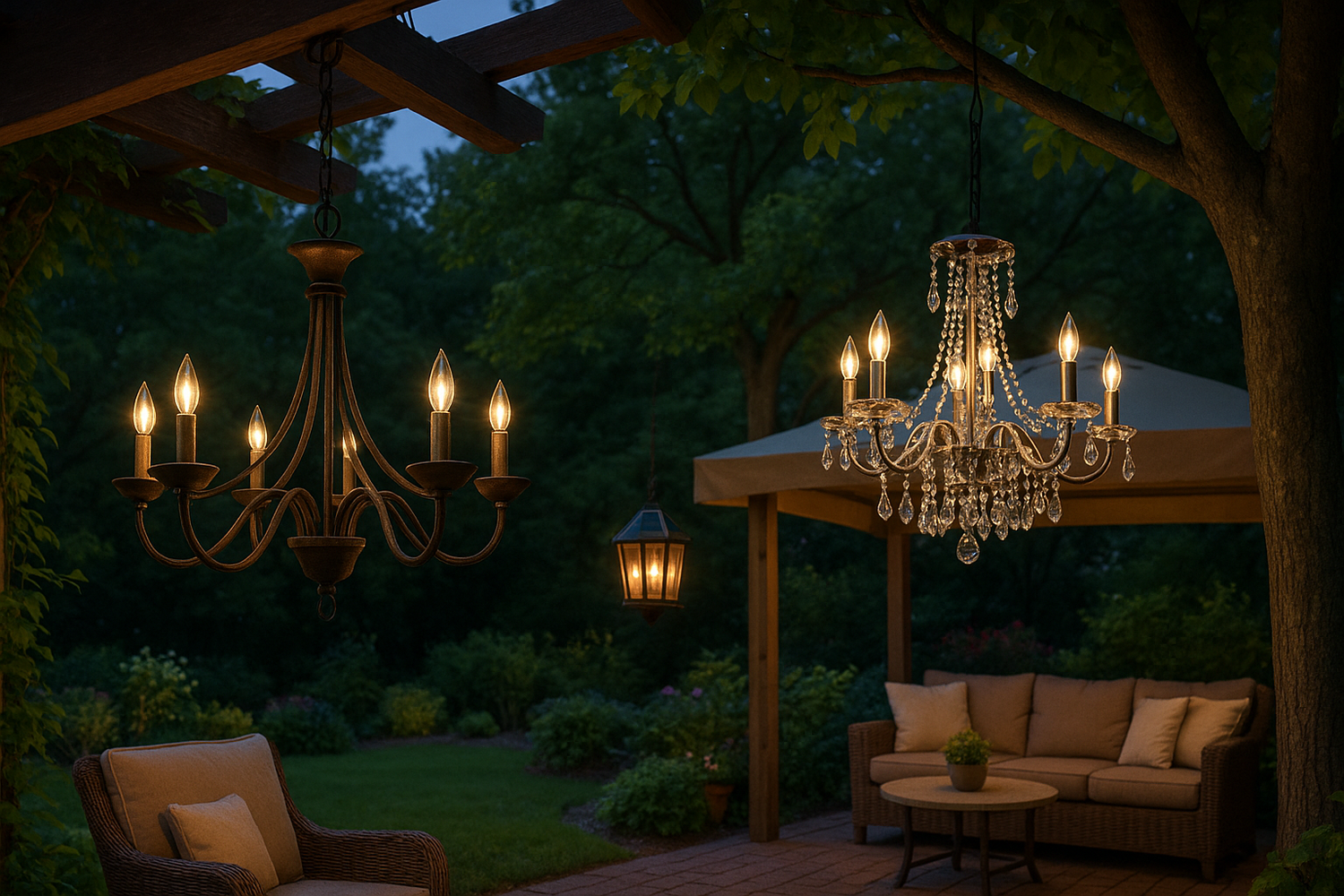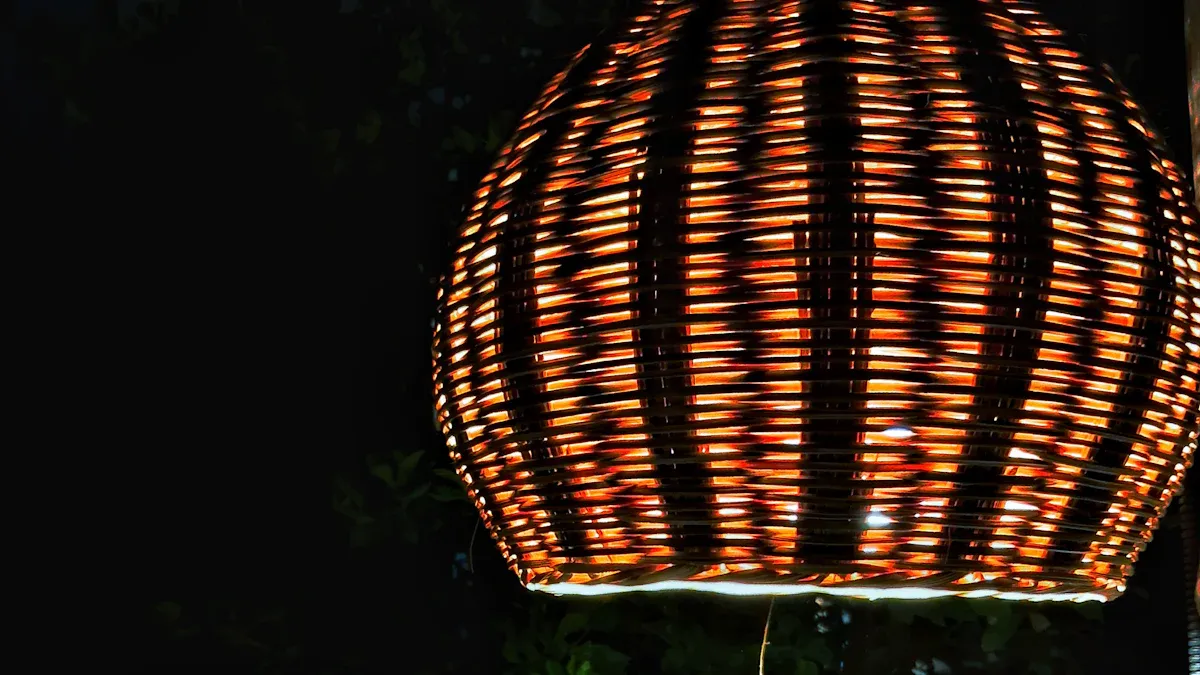
Picking the right solar chandelier can transform your outdoor lighting. You want a style that fits your space, matches your lighting needs, and stands up to the elements. Check how much sunlight your area gets and think about the size of your space for efficient charging and great coverage. Enjoy the perks—solar chandeliers save energy and help the environment. Look for options that make installation and maintenance easy.
- Tip: A hassle-free setup means more time enjoying your outdoor lighting!
Key Takeaways
- Solar chandeliers save energy and help the environment by using sunlight instead of electricity.
- Choose a solar chandelier size and style that fits your outdoor space and matches your décor.
- Place the solar panel where it gets at least six hours of direct sunlight for best charging.
- Look for durable, weather-resistant materials and a good IP rating to protect your chandelier.
- Adjustable brightness and color temperature let you create the perfect mood for any occasion.
- Easy installation means no wiring or professional help is needed; just hang and charge.
- Regularly clean solar panels and check batteries to keep your chandelier shining bright.
- Consider battery capacity and panel type to ensure your light lasts all night, even in winter.
Solar Chandelier Benefits
Eco-Friendly Lighting
You want your outdoor space to look great, but you also care about the planet. Solar chandeliers make it easy to do both. These fixtures harness sunlight, a renewable resource, so you cut down on fossil fuel use and lower greenhouse gas emissions. When you choose solar-powered lights, you help create a more sustainable outdoor area.
- Solar chandeliers use sunlight, which means you reduce your carbon footprint.
- You don’t need to connect to the electrical grid, so you avoid extra emissions.
- Minimal wiring and easy setup mean less material waste.
- You can place outdoor solar lights almost anywhere, so you don’t disturb your landscaping.
Switching to solar-powered lights for your outdoor lighting means you support environmental conservation. You also help reduce air pollution and even the urban heat island effect. Compared to traditional outdoor lighting, solar chandeliers offer a cleaner, greener way to brighten your evenings.
Energy Savings
You probably notice your energy bills go up when you add more lights outside. Solar chandeliers change that. They run on free energy from the sun, so you don’t pay for electricity. Over time, this can save you a lot of money, especially if you use several outdoor solar lights around your yard or patio.
Solar-powered lights also last longer than many traditional bulbs. LEDs in these fixtures can shine for up to 50,000 hours. That means you replace bulbs less often and spend less on maintenance. Plus, you avoid the hassle of running wires or hiring an electrician. Your outdoor lighting becomes both affordable and reliable.
Tip: Solar-powered lights work best when you place them where they get direct sunlight for most of the day.
Easy Installation
You don’t need to be an expert to install a solar chandelier. Most models come with simple instructions and all the parts you need. You just hang the fixture, place the solar panel where it gets sun, and let it charge. No digging, no wiring, and no need to call a professional.
Outdoor solar lights give you flexibility. You can move them if you change your outdoor setup or want to try a new look. Since there’s no wiring, you avoid damaging your garden or patio. Maintenance stays simple, too. Just wipe the panels clean and check the batteries now and then.
Solar chandeliers stand out as one of the best lighting solutions for outdoor spaces. They combine style, sustainability, and convenience, making them a smart choice for anyone who wants to upgrade their outdoor lighting.
Style & Design
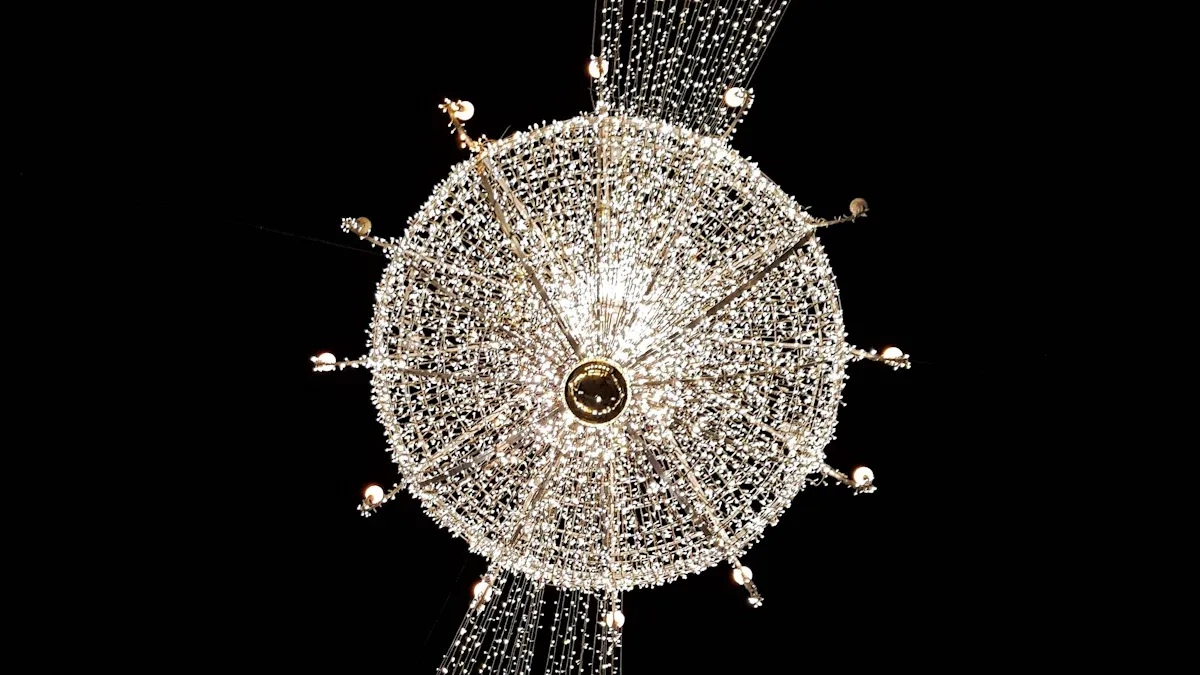
Outdoor Décor Match
You want your outdoor space to feel inviting and reflect your personal style. Solar chandeliers come in a wide range of designs, so you can easily find one that matches your décor. Whether your patio leans modern, rustic, or classic, there’s a fixture that fits right in.
- Modern styles look sleek and clean, perfect for contemporary patios.
- Rustic chandeliers add warmth and charm, great for farmhouse or cottage-inspired spaces.
- Vintage-inspired designs bring a touch of nostalgia, making garden nooks feel magical.
- Ornate fixtures stand out as statement pieces, while minimalist options blend in quietly.
If you love creating ambiance, try pairing your solar chandelier with string lights. This combo works wonders for a cozy atmosphere, especially during evening gatherings. You can mix and match styles, too. For example, vintage pendants with string lights create a whimsical vibe, while modern chandeliers with simple string lights keep things fresh and uncluttered.
Tip: Think about the mood you want to set. Are you after a lively party spot or a peaceful retreat? The right chandelier helps you achieve the perfect ambiance.
Size & Scale
Getting the size right makes a big difference in how your chandelier looks and works. For patios, gardens, or large outdoor areas, you’ll want a fixture that stands out but doesn’t overwhelm the space. Large solar chandeliers often feature multiple lights—like 8-light or 10-light designs. These usually measure around 25 to 28 inches tall and 13 to 16 inches wide, sometimes even larger.
Many of the best outdoor lights come with adjustable hanging chains or downrods. This lets you customize the height, so your chandelier fits perfectly above a dining table, in a gazebo, or on a porch. You can also find dimmable options, which help with creating ambiance for different occasions.
If you have a smaller patio or a cozy corner, a compact chandelier or a cluster of string lights might work better. These options keep the space feeling open while still providing enough light for a cozy atmosphere.
Here’s a quick guide to help you choose the right size:
|
Space Type |
Recommended Chandelier Size |
Lighting Tip |
|---|---|---|
|
Large Patio/Garden |
25-28" height, 13-16"+ width, 8-10 lights |
Use as a focal point for gatherings |
|
Small Patio/Nook |
12-18" height, 8-12" width, 3-5 lights |
Pair with string lights for extra glow |
Material Choices
Outdoor solar chandeliers need to handle sun, rain, and wind. You want materials that last and keep looking good. Steel is a top pick for durability. It stands up to rain and physical impact, so your chandelier keeps shining season after season. Durable plastics also work well. They resist weather and make installation easy.
When you shop for the best outdoor lights, check for waterproofing, UV resistance, and impact protection. These features help your chandelier last longer and keep its good looks. Some fixtures use weatherproof finishes like matte black or English bronze, which add style and extra protection.
If you care about the environment, look for chandeliers made from recyclable or sustainable materials. This choice supports eco-friendly living while still giving you a strong, stylish fixture.
Note: Combining your chandelier with string lights made from similar durable materials can boost both style and longevity. You’ll enjoy a beautiful, reliable setup that’s perfect for creating ambiance all year long.
Light Quality & Coverage
When you pick a solar chandelier, you want more than just a pretty fixture. You need the right light quality and coverage to make your outdoor space shine. Let’s break down what matters most.
Brightness Levels
Brightness can make or break your outdoor lighting experience. If your chandelier is too dim, you might struggle to see your guests or your dinner. If it’s too bright, you lose that cozy feeling and might even annoy your neighbors. Most solar chandeliers use LED bulbs, which give you plenty of light without using much energy.
You’ll find models with adjustable brightness. This feature lets you set the mood for any occasion. Want a soft glow for a quiet evening? Turn it down. Hosting a lively barbecue? Crank it up. Adjustable brightness gives you control, so your chandelier works for every event.
Tip: Check the lumens rating when you shop. More lumens mean a brighter light. For most patios, 200 to 400 lumens per fixture works well for general use.
Color Temperature
Color temperature changes how your outdoor space feels. Warm tones, like golds and oranges, create a cozy and inviting atmosphere. These shades remind you of a campfire or sunset. Most people love this look for patios and relaxation areas. Warm color temperatures, usually between 2700K and 3000K, help you build intimate “pools of light.” These spots encourage people to relax and stay longer.
Modern outdoor lighting trends include color-changing LEDs. You can switch from warm to cool tones for different events or seasons. Cooler temperatures, above 4000K, make your space feel more alert and vibrant. These work better for security or when you need to see clearly. But if you want ambiance, stick with warm tones. Adjustable color temperature lets you customize your lighting solutions for every occasion.
Light Distribution
How your chandelier spreads light matters just as much as brightness or color. You want even coverage so every corner of your patio or garden feels welcoming. Symmetrical light distribution works best for general outdoor lighting. It gives you a uniform glow, perfect for gatherings or dining areas.
If you need to light up a path or highlight a special spot, look for fixtures with asymmetrical patterns or narrow beam angles. These focus the light where you need it most. Wider beam angles, over 60 degrees, cover large areas and help you avoid dark patches.
Here’s a quick guide to light distribution patterns:
|
Pattern Type |
Best For |
Example Use |
|---|---|---|
|
Symmetrical |
Uniform area lighting |
Patios, decks, gardens |
|
Asymmetrical |
Directional/pathway lighting |
Walkways, driveways |
|
Narrow Beam (<30°) |
Highlighting features |
Statues, plants, art |
|
Wide Beam (>60°) |
Broad coverage |
Large seating areas |
When you choose the right light distribution, your outdoor lighting feels balanced and functional. You get the best lighting solutions for every part of your yard.
Solar Panel & Battery
Sunlight Exposure
You want your solar chandelier to shine all night, so sunlight exposure matters a lot. The solar panel needs direct sunlight to charge the battery efficiently. If you place your outdoor solar lights in a spot with shade or indirect light, you’ll notice weaker performance. Here’s what you should keep in mind:
- Solar-powered lights need at least a few hours of direct sunlight every day for optimal charging.
- The best charging happens during prime sun hours, usually between 10 AM and 3 PM.
- If your solar panel sits in partial shade, it only charges at about 10% to 25% of its full power.
- Several hours of midday shade can seriously reduce how much energy your chandelier stores.
- Always position the solar panel in an open area, away from trees, buildings, or anything that casts shadows.
- In the Northern Hemisphere, aim the panel south to catch the most sun.
Tip: Walk around your outdoor space at different times of day. Notice where the sun hits hardest. That’s the best spot for your solar chandelier’s panel.
Panel Type
Choosing the right panel type helps you get the most out of your outdoor solar lights. You’ll see two main options: monocrystalline and polycrystalline panels. Each has its own strengths. Take a look at the table below to compare them:
|
Aspect |
Monocrystalline Panels |
Polycrystalline Panels |
|---|---|---|
|
Manufacturing Process |
Single, continuous silicon crystals; complex and costly |
Melting multiple silicon fragments; simpler and cheaper |
|
Efficiency |
Higher (18-22%) |
Lower (15-17%) |
|
Appearance |
Uniform dark black or blue-black |
Blue, speckled appearance |
|
Cost |
More expensive due to complex process |
15-25% less expensive |
|
Space Suitability |
Ideal for space-constrained applications |
Suitable where space is ample |
|
Temperature Coefficient |
Around -0.40% to -0.45% per °C (better in heat) |
Around -0.45% to -0.50% per °C |
|
Performance in Partial Shading |
Maintains efficiency advantage |
Slightly less efficient |
|
Application Relevance |
Preferred for solar chandeliers needing compact, efficient panels |
Cost-effective alternative when space and budget allow |
If you want maximum efficiency and have limited space, monocrystalline panels are the way to go. If you have plenty of room and want to save money, polycrystalline panels work well for most outdoor solar lights.
Battery Capacity
Battery capacity decides how long your solar-powered lights stay on after sunset. You want a battery that lasts all night, especially if you love late-night gatherings or want security lighting. Here’s a quick look at the most effective battery options:
|
Battery Type and Capacity |
Voltage |
Working Time |
Charging Time |
|---|---|---|---|
|
18650 lithium battery |
3.7V |
6+ hours |
6-8 hours |
|
32650 lithium battery |
3.2V |
6-10 hours |
6-8 hours |
The 32650 lithium battery with a 5500mAh capacity stands out. It powers your chandelier for 6 to 10 hours, which means you get reliable illumination all night long. Many users say these batteries keep their outdoor solar lights glowing until morning.
You’ll also see lithium iron phosphate batteries in some solar-powered lights. These batteries last up to 10 years and handle temperature changes well. When you pick a chandelier, check the battery specs. A capacity around 5500mAh gives you the best chance for all-night lighting, even if the weather isn’t perfect.
Note: If you live in an area with cloudy days or short winter sunlight, choose a chandelier with a larger battery. That way, your outdoor solar lights won’t let you down when you need them most.
Weather Resistance
When you pick a solar chandelier for your outdoor space, you want it to last through all kinds of weather. Rain, dust, sun, and even snow can test your fixture. Let’s look at what makes a solar chandelier truly weather-resistant.
IP Rating
The IP rating tells you how well your chandelier stands up to dust and water. You’ll see numbers like IP65 or IP67 on product labels. These numbers matter a lot if you want your chandelier to keep shining after a storm or a windy day.
Here’s a quick guide to help you choose the right IP rating for your environment:
|
Environment Type |
Recommended IP Rating |
Protection Focus |
|---|---|---|
|
Standard urban outdoor use |
IP65 |
Complete dust protection; resists low-pressure water jets (rain) |
|
Coastal or high-humidity |
IP66 / IP67 |
Protection against heavy rain, dust storms, salt fog, and corrosion |
|
Desert or dusty regions |
IP6X |
Complete dust sealing |
|
Flood-prone areas |
IP68 |
Protection against long-term water immersion |
|
Extreme cold and snowy areas |
IP67+ |
Ice resistance and prevention of meltwater seepage |
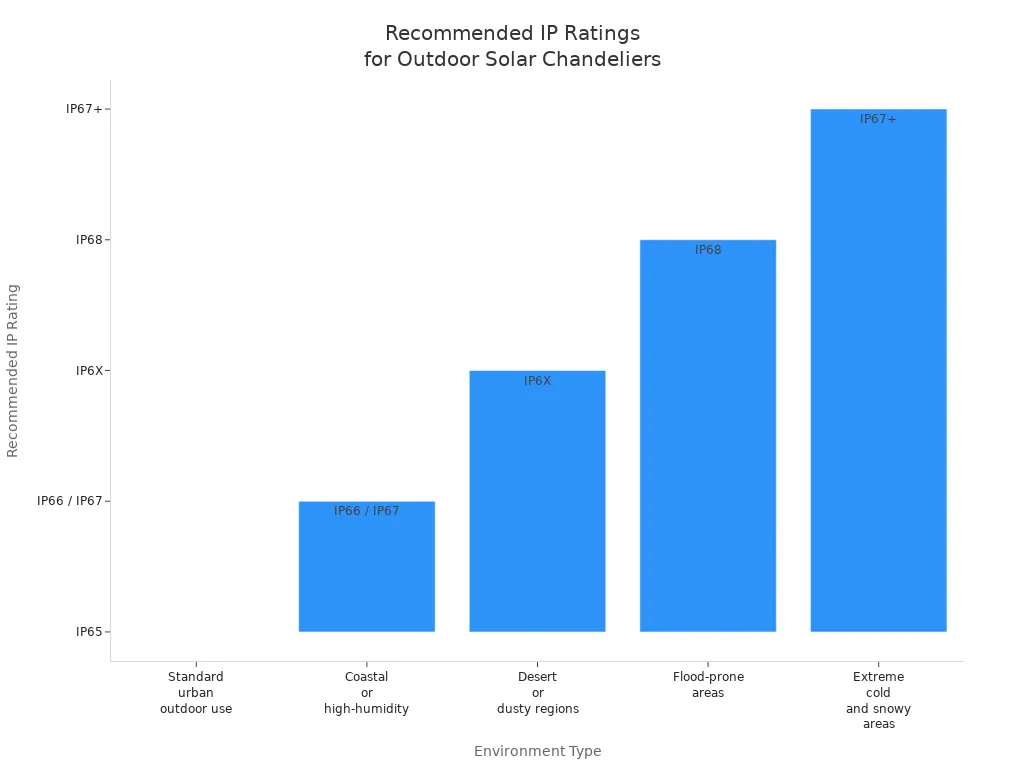
If you live in a city or suburb, an IP65 chandelier usually does the trick. For coastal homes or places with heavy rain, go for IP66 or IP67. In dusty or desert areas, look for IP6X or higher. If your yard floods or gets lots of snow, IP68 or IP67+ gives you peace of mind.
Tip: Always check the IP rating before you buy. It’s your best defense against weather damage.
Durable Construction
A tough chandelier handles more than just water. You want strong materials that won’t rust, crack, or fade. Stainless steel and powder-coated metals work well for frames. They resist rust and hold up against bumps or knocks. High-quality plastics also help. They don’t warp in the sun or get brittle in the cold.
Look for features like sealed joints and rubber gaskets. These keep water and dust out of the wiring and battery. Some chandeliers use shatterproof glass or acrylic for the shades. This means you don’t have to worry about broken pieces after a storm.
- Stainless steel frames resist rust
- Powder-coated finishes add extra protection
- Shatterproof shades prevent breakage
You get a chandelier that looks good and works well, season after season.
UV Protection
The sun can do more than charge your solar panel. It can also fade colors and weaken materials over time. UV protection keeps your chandelier looking fresh and strong. Many outdoor fixtures use UV-resistant coatings on metal and plastic parts. These coatings block the sun’s rays and stop fading or cracking.
If you want your chandelier to stay bright and beautiful, check for UV protection in the product details. This small feature makes a big difference, especially if your fixture hangs in direct sunlight all day.
Note: UV protection helps your chandelier last longer and keeps it looking new, even after years outside. 🌞
Installation & Maintenance
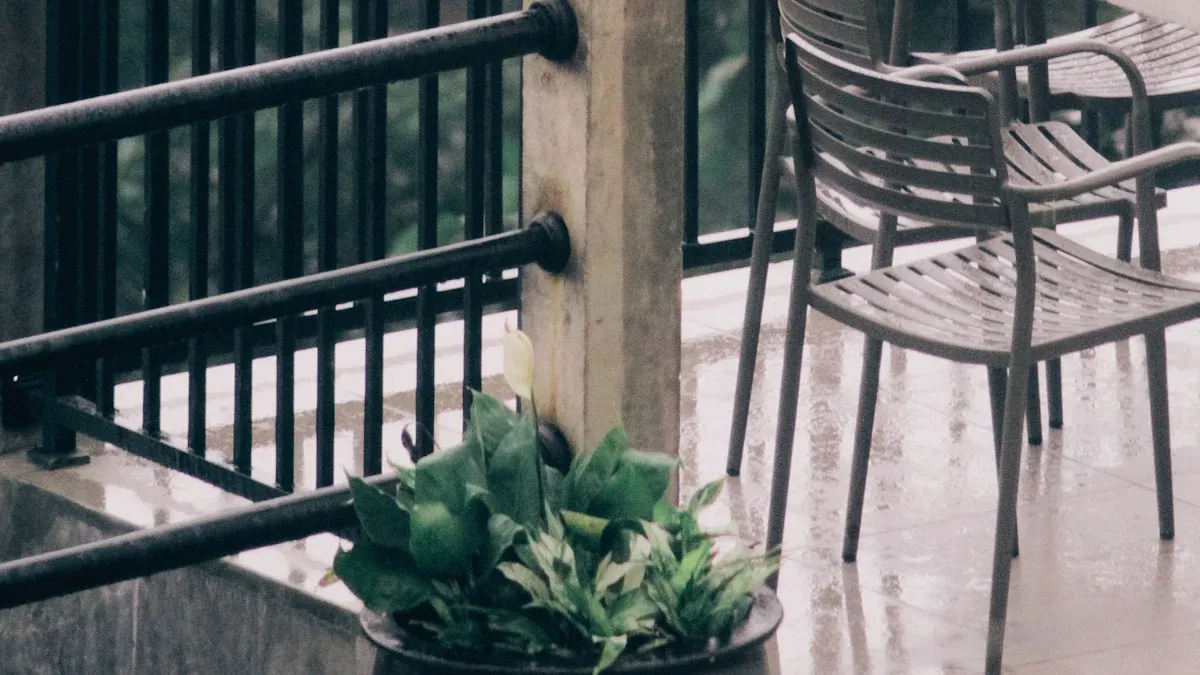
Setup Steps
Setting up your solar chandelier outdoors feels easy when you follow a few simple steps. First, pick a spot that gets plenty of direct sunlight. You want at least six hours of sun each day for the best charging. Next, check the area for any shade from trees or buildings. If you see shadows during midday, try another location.
Here’s a quick checklist to help you avoid common installation challenges:
- Assess the site for sunlight and stable ground. Soft soil or uneven surfaces can cause problems with mounting.
- Watch out for underground utilities before you dig or install anchors.
- Use quality mounting hardware and make sure all connections are tight. Loose wires or poor seals can let water in and cause failures.
- If you need to work at height, use proper safety gear and follow instructions for DC electrical systems.
- Plan for weather. Rain, wind, or extreme temperatures can delay installation or affect concrete work.
- Choose genuine components. Counterfeit parts may fail early and cost you more in the long run.
Tip: Always double-check your wiring and seals before you finish. A little extra care now saves you headaches later.
Maintenance Tips
Regular maintenance keeps your solar chandelier shining bright. You don’t need to spend hours on upkeep, but a few simple tasks make a big difference. Here’s a table to guide you:
|
Maintenance Aspect |
Recommended Frequency/Interval |
Notes |
|---|---|---|
|
Cleaning Solar Panels |
Every few weeks or at least a couple of times each season |
Wipe panels with a soft cloth to remove dust and dirt. |
|
Optimizing Sun Exposure |
Daily |
Make sure nothing blocks sunlight, like branches or debris. |
|
Avoiding Extreme Temperatures |
Seasonal (especially winter) |
In cold weather, consider bringing lights inside or turning them off. |
|
Battery Replacement (NiMH/NiCd) |
Every 1-2 years |
Replace all batteries together for best results. |
|
Battery Replacement (Li-ion) |
Every 3-5 years |
Lithium-ion batteries last longer but still need replacement. |
|
Battery Replacement (LiFePO4) |
Every 5-10 years |
These batteries offer a low-maintenance experience. |
Note: Clean solar panels often. Dust and dirt block sunlight and reduce charging efficiency.
Troubleshooting
If your solar chandelier doesn’t light up at night, don’t worry. You can fix most issues with a few quick checks. Start with a three-minute pre-check:
- Measure battery voltage using a multimeter. A fully charged battery should read between 1.2V and 3.7V.
- Clean the solar panel with a microfiber cloth and a little isopropyl alcohol.
- Cover the sensor at dusk to simulate darkness. The light should turn on within ten seconds.
If the chandelier still won’t work, try these steps:
- Inspect the solar panel for cracks, yellowing, or dark spots. Measure voltage output in sunlight. If it’s below 0.5V, you may need a new panel.
- Check battery health. Look for swelling, corrosion, or short runtime. Replace batteries with the correct type and capacity.
- Examine LEDs and sensors. Dim lights or random on/off cycles point to sensor or LED problems. Replace parts as needed and reset the sensor by covering it for thirty seconds after installation.
- Check all connections for looseness or corrosion. Clean terminals gently if you see any buildup.
- Consider environmental factors. Move the chandelier if shade or weather reduces sunlight.
Tip: Seasonal inspections help you catch problems early and keep your chandelier working year-round. 🛠️
Best Outdoor Solar Lighting Choices
Top Features
When you look for the best outdoor solar lighting, you want features that make your life easier and your space brighter. Many top models offer adjustable brightness, so you can set the mood for any occasion. Some chandeliers include remote controls, letting you change settings without leaving your seat. You might see smart sensors that turn the lights on at dusk and off at dawn. These features save energy and keep your outdoor lighting hassle-free.
You also want durability. The best outdoor lights use weather-resistant materials and strong construction. Look for waterproof ratings and UV protection. These details help your chandelier last through rain, wind, and sun. If you love hosting parties, consider models that pair well with string lights. This combo creates a festive atmosphere and adds extra sparkle to your evenings.
Tip: Choose outdoor solar lights with long-lasting batteries and efficient solar panels. You get more hours of light and less time worrying about recharging.
Flexible Placement
Placement flexibility makes a big difference in how you use outdoor solar lights. Some chandeliers, like the JACKYLED Solar Lights, come with separate solar panels and long extension cords. You can install the light unit where you want illumination, such as under a gazebo or on a porch. Then, you place the solar panel up to 16 feet away in a sunny spot. This design lets you maximize solar charging, even if your favorite seating area sits in the shade.
You don’t have to limit your creativity. Hang your chandelier above a dining table, or use string lights to highlight pathways and garden beds. With flexible placement, you can create layers of outdoor lighting that suit every part of your yard. You get the freedom to design your space just the way you like.
|
Feature |
Benefit |
|---|---|
|
Separate solar panel |
Optimal sun exposure |
|
Long extension cord |
Flexible installation |
|
Wireless design |
No need for complex wiring |
|
Pairing with string lights |
Enhanced ambiance |
Reliable Performance
Reliability matters when you invest in outdoor solar lights. You want your chandelier to shine every night, no matter the weather. Performance metrics help you judge which models stand out. Look for high luminous efficacy, which means you get more light for less energy. Check the system efficiency, including the solar panel, battery, and LED bulbs. Good battery performance keeps your lights glowing, even when temperatures drop.
Longevity is key. The best outdoor lights use components that last for years. Regular maintenance, like cleaning solar panels and checking batteries, helps sustain performance. Some models include smart features, such as sensors or IoT technology, that boost energy efficiency and reliability. You get peace of mind knowing your outdoor lighting will work when you need it.
- Luminous efficacy (lumens per watt)
- System efficiency (solar panel, battery, LED)
- Battery performance in all temperatures
- Longevity of solar panels, batteries, and LEDs
- Easy maintenance practices
- Smart features for energy savings
Note: Reliable outdoor solar lights mean fewer replacements and more time enjoying your outdoor space.
When you pick a solar chandelier, keep these key factors to consider in mind:
- Style and placement that match your outdoor décor
- Sunlight exposure for efficient charging
- Area size and brightness needs
- Light quality and color temperature
- Weather resistance and easy installation
You can create a welcoming space with the right lighting. Explore new solar options for your garden or patio and enjoy reliable, eco-friendly illumination every night.
Ready to upgrade your outdoor lighting? Discover the latest solar solutions and find the perfect fit for your home!
FAQ
How long does a solar chandelier need to charge in sunlight?
You usually need about 6 to 8 hours of direct sunlight for a full charge. If your chandelier gets less sun, it may not shine as bright or last as long at night.
Can you use a solar chandelier in shaded areas?
You can, but performance drops. Try placing the solar panel in a sunny spot using an extension cord. This way, your chandelier still gets enough energy to light up your space.
What happens if it rains or snows?
Most outdoor solar chandeliers have waterproof ratings like IP65 or higher. They keep working in rain or snow. Always check the product’s IP rating before you buy.
How bright are solar chandeliers compared to wired lights?
Solar chandeliers use LED bulbs. They give you good brightness for patios and gardens. Wired lights can be brighter, but solar models save energy and work well for most outdoor needs.
Do you need to replace the batteries often?
You don’t need to replace batteries often. Lithium-ion batteries last 3 to 5 years. Some models use lithium iron phosphate batteries, which can last up to 10 years.
Can you adjust the brightness or color of the light?
Many solar chandeliers let you adjust brightness. Some offer color-changing LEDs. You can set the mood for parties or quiet evenings with just a click or remote control.
How do you clean and maintain a solar chandelier?
Wipe the solar panel with a soft cloth every few weeks. Check for dirt or debris. Replace batteries when needed. Inspect for loose wires or damage after storms.
Will a solar chandelier work during winter?
Yes, but shorter days mean less charging time. Your chandelier may shine for fewer hours. Choose a model with a large battery for better winter performance.
